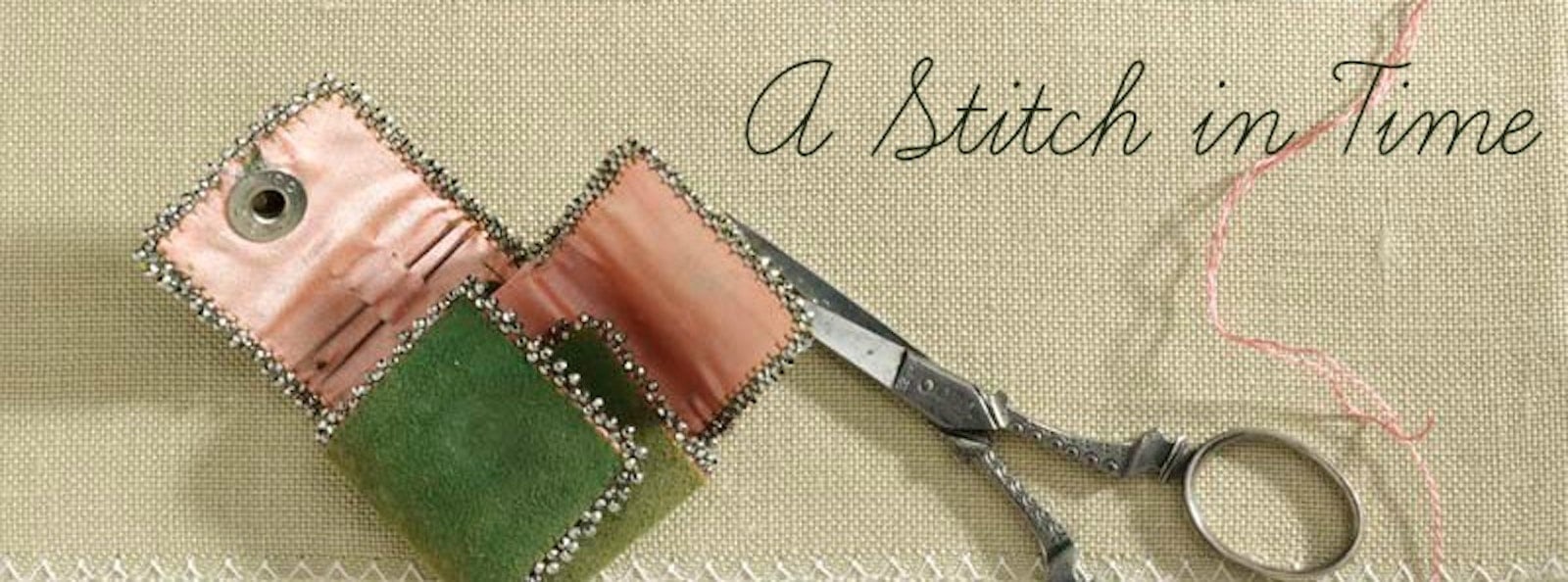The feather stitch and its countless variations create feathery straight or undulating lines and fall in the category of looped stitches. The feather stitch is actually a variation of the blanket stitch, but it alternates from one side to the other.
The Cretan stitch is considered by some embroiderers to be simply another variation of the feather stitch. The long-and-short stitch sometimes is referred to as a feather or feather-work stitch, but the long-and-short stitch is a series of long-and-short straight stitches and in no way resembles the feather stitch with its looped structure.
Left to Right: Figures 1, 3, & 4.
The history of the feather stitch is long and impressive, dating from the mid-eighteenth century when Welsh and English peasants used it to decorate their smocked work garments. Late- nineteenth- and early-twentieth-century samplers featuring dressmaking and fabric repair processes often contained feather stitches as decorative line patterns or in the actual hemstitching. During the 1950s the women’s institutes of Dorset, England, designed a distinct embroidery style called Dorset feather stitching based on traditional patterns from English and Welsh smocked peasant embroideries. Dorset feather stitching traditionally embellished aprons, caps, blouses, skirts, and table linens.
Figure 2.
The feather stitch may be worked vertically from the top to the bottom and alternated from left to right or right to left (Figure 1) or worked horizontally (Figure 2). For all stitch variations, hold the loop of thread (1 to 2 in Figure 1) down with your thumb while you pull the needle up at position 3, then snug the thread loop up against the emerging thread before proceeding to the next stitch; to end a line of feather stitches, make a short tacking stitch (a-b in Figures 1 and 2); use an embroidery hoop or frame to keep the fabric from puckering. The legs of the feather stitches may be the same length (Figures 1, 2, 5, 6) or not (Figures 3 and 8).
Left to Right: Figures 5, 6, & 7.
Variations of the feather stitch include the briar or single coral (it resembles coral growing in the ocean), straight, double, closed, single, maidenhair, chained, and Spanish knotted. In the straight feather stitch (Figure 4), the placement of the beginning of the next stitch is directly below the ending of the previous stitch, causing the stitches to be more angular in appearance. The double feather stitch (Figure 5), also known as the double coral stitch, is a wider variation of the basic stitch; instead of single stitches alternating from side to side, pairs of stitches alternate. (The triple feather stitch alternates groups of three stitches, and so on). The closed feather stitch (Figure 6A and B) also goes by the name double chain stitch and is worked in the same manner as the straight feather stitch except that the stitches touch each other, forming a closed, unbroken band (note the difference in the placement of the stitches in the encircled areas in Figure 6A and B). The slanted or single feather stitch (Figure 7), also known as the slanted blanket stitch, is similar in appearance to the blanket stitch except that the legs are stitched at an angle, making this the only variation in which the stitching does not alternate from side to side. The maidenhair stitch (Figure 8), as its name suggests, resembles the maidenhair fern. The chained feather stitch (Figure 9), also known as the feathered chain stitch, alternates from side to side but begins with a single chain (lazy daisy) stitch. The Spanish knotted feather stitch, also known as the twisted zigzag chain stitch (Figure 10), is more textured and complex than the other variations and requires practice to achieve even tension and accurate positioning. A round, twisted thread is the best choice for this variation.
Left to Right: Figures 8, 9, 10, & 11.
Threads and fabrics for the feather stitch and its relatives are unlimited. The main thread criteria are appropriate weight and tensile strength for the background fabric, stitch size, and effect desired. It’s easier to work this stitch on evenweave fabrics because the individual fabric threads may be used to keep the feather stitches in proper alignment; good choices are linen, hardanger, Jobelin, and Lugana. On nonevenweave fabrics such as cotton percale, wool, and douppioni silk, it’s helpful to mark vertical stitching guidelines with a pencil or water-soluble pen (the red dashes on some of the stitch diagrams indicate such markings).
Applications for the feather stitch and its variations are varied and many, and appear in many different needlework disciplines—smocking, hemstitching, ribbon embroidery, crazy quilting, traditional surface and crewel embroidery, and counted-thread techniques. Use it for bands, borders, backgrounds, fillings, as well as for grass, ferns, flowers, shrubs and trees, and coral and seaweed. Lace it (Figure 11) or use it in conjunction with other stitches to create even more elaborate stitches and patterns. Straight, closed, single, and chained feather stitches are useful as couching stitches to hold down ribbon, cord, or other threads or groups of threads.
Deanna
This seventh installment of Deanna’s stitch tutorials originally appeared in the January/February 2003 issue of PieceWork, along with instructions for cross-stitching a stellar needle holder with a striking Quaker motif and much more. Deanna is PieceWork’s needlework technical editor; she previously was the editor of The Needleworker magazine. Stay tuned for more stitch tutorials from Deanna in the weeks ahead! Read the entire "Stitch in Time" series!
Featured Image: Scissors and needle case courtesy of Loene McIntyre. Photo by Joe Coca.





